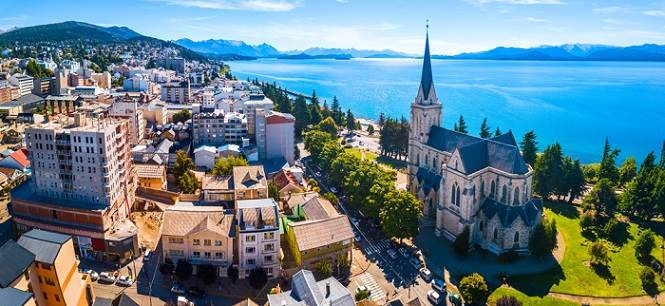Founded in 1902, the Patagonian town of Bariloche is strung out along the shoreline of Lake Nahuel Huapi, in the middle of the national park of the same name. Located at the foothills of the Andes, the lofty peaks of Catedral, López, Nireco and Shaihuenque all surpass 2000 metres and circle the town, giving postcard-perfect views from across the town.
Its scenic beauty often licenses the label of the ‘Switzerland of South America’, and not entirely unmerited: Bariloche is known for its Alpine architecture, which is given a Patagonian flavour via indigenous hardwoods and local stonework. It is also the chocolate capital of Argentina; chocoholics can expect to be inundated by storefront after storefront abounding in chocolaty decadence.
Bariloche is a year-round haven for adventure-minded and active visitors, with no end of opportunities to explore the surrounding wilderness by horse, hiking, paragliding, rafting, kayaking, mountain biking, and in the winter, skiing at Cerro Catedral.
There is exceptional snow coverage, sometimes exceeding 2 metres even at the end of the season, which lures skiers and snowboarders from all over the world to this winter wonderland. Adrenaline junkies can take the plunge into freezing Lake Nahuel Huapi, which, even in summer, never rises above an icy average temperature of 57°F or 14°C.
The summertime will also keep lovers of the great outdoors busy with hills to climb, trails to hike, and trout to fish and trails for mountain bikers and horse riders. Beaches like Playa Bonita and Villa Tacul are havens for sunbathers. The one month that may be worth avoiding is July, when Argentine and Chilean high-school students inundate the town to celebrate the holidays.
The city itself will keep you busy. There are historic buildings, museums and shops to explore, as well as discos, pubs, restaurants and even a modern casino to help you enjoy the evenings of your stay after watching spectacular sunsets.
Other Bariloche travel highlights include:
Nahuel Hupi National Park – The first Argentine national park, established in 1934. The park is dominated by the Andes Mountains and is also home to numerous lakes, rivers, waterfalls, glaciers and forests. You will find a wealth of unique flora and fauna as well as many ancient indigenous rock art sites. Nahuelito is a lake monster of which sightings are widely reported. Whether it is fact or fiction both tourists and locals have witnessed seeing ‘a giant water snake with humps and fish like fins’.
Cerro Tronador – An extinct volcano, named ‘Thunderer’ in Spanish. It hosts eight glaciers and is a popular mountaineering destination. A great day trip. Expect panoramas of turquoise blue lakes, and glaciers. Can be accessed by car or gondola. Take insect repellent and sun cream.
Catedral de San Carlos Bariloche – Looks like a European cathedral, and is one of the most beautiful places to visit to Bariloche. It is nice and warm and quiet inside.
Lago Gutierrez – Beautiful lake with clear waters. Best explored by kayaking or taking a picnic to the shore. A great place to fish too as the lake is home to several species of trout.
Fenoglio Museo de Chocolate – A fun and tasty outing, especially if it’s raining. Take a half hour tour to find out all about chocolate production and history.
Piedras Blancas – One of the best places for families to go skiing or snowboarding. If you have kids below 5, there is a kids yard available. Credit cards are not accepted.
Centro Civico – A great place to visit on your first day in Bariloche. The magic of a mountain town is concentrated in this city centre. It has restaurants, shops, places to eat fondue, pubs and shops that rent ski gear.
Museo de la Patagonia – A great way to educate yourself about Patagonia. Find out about the local land, climate, flora and fauna as well as indigenous and settler history. Located close to the city centre.


